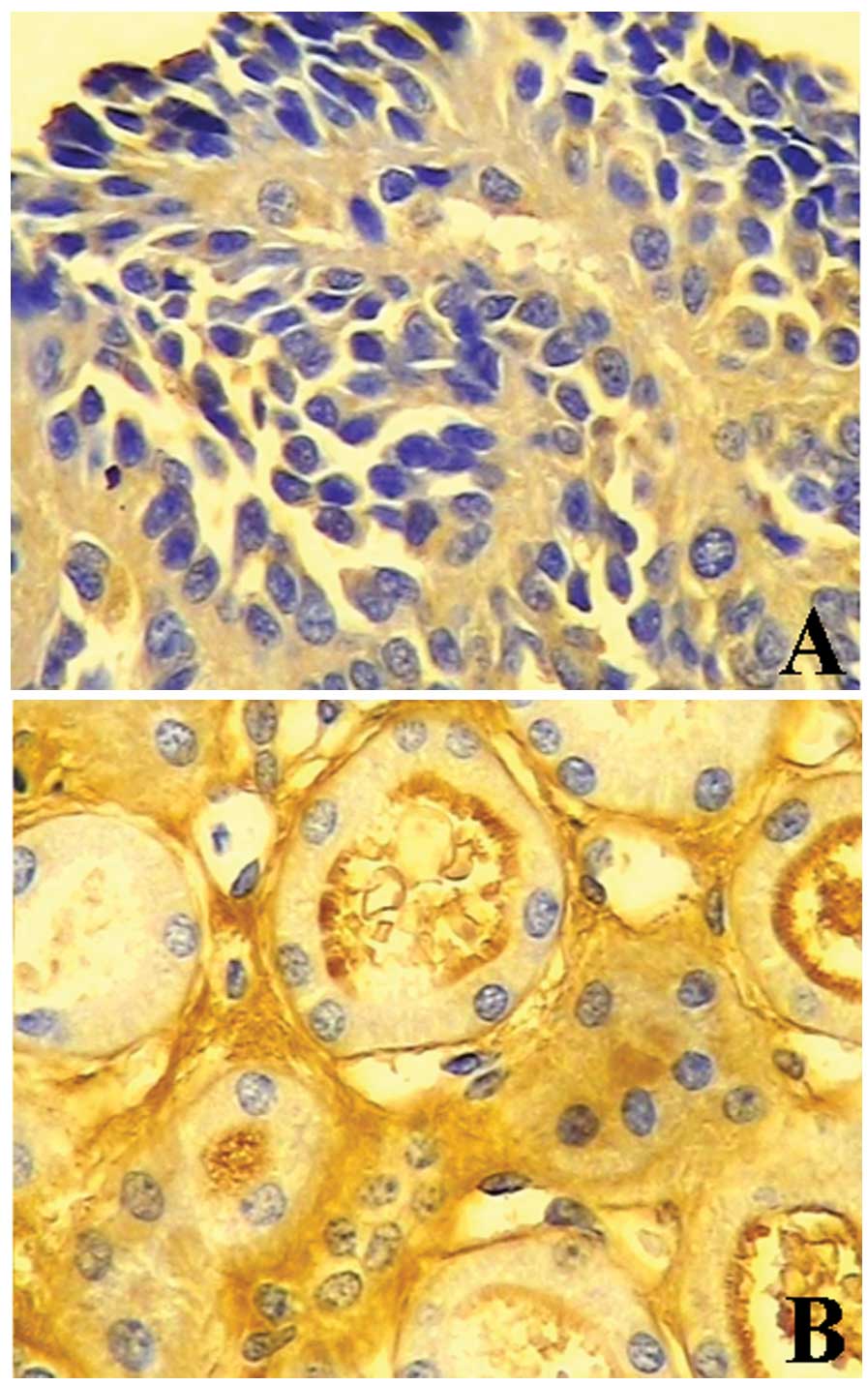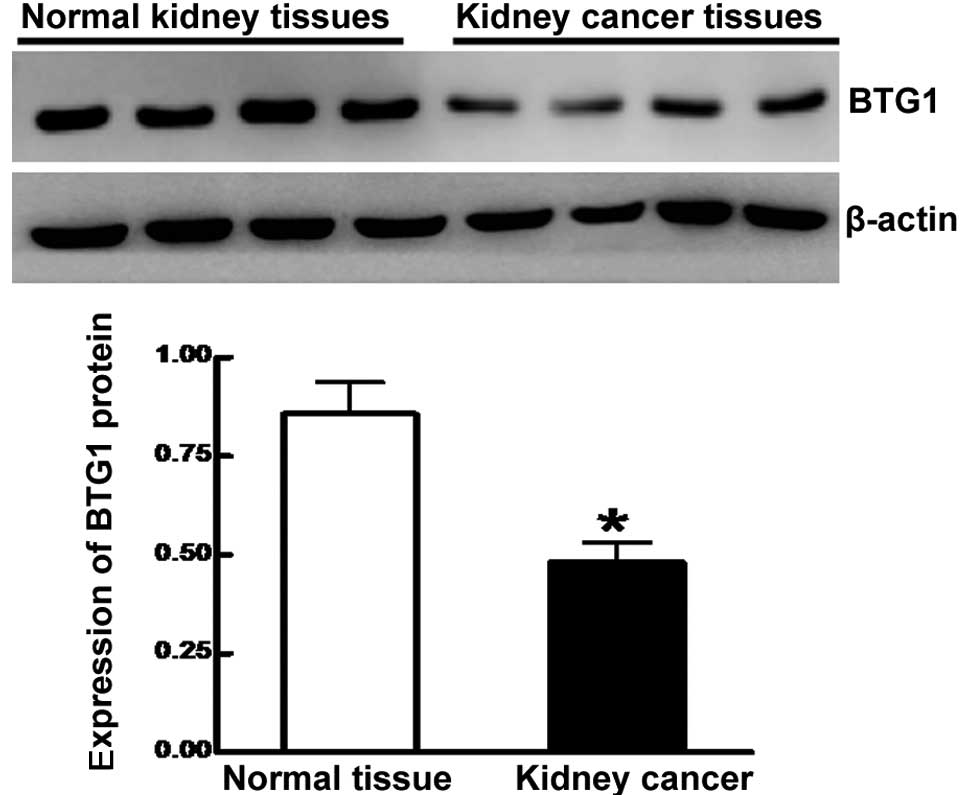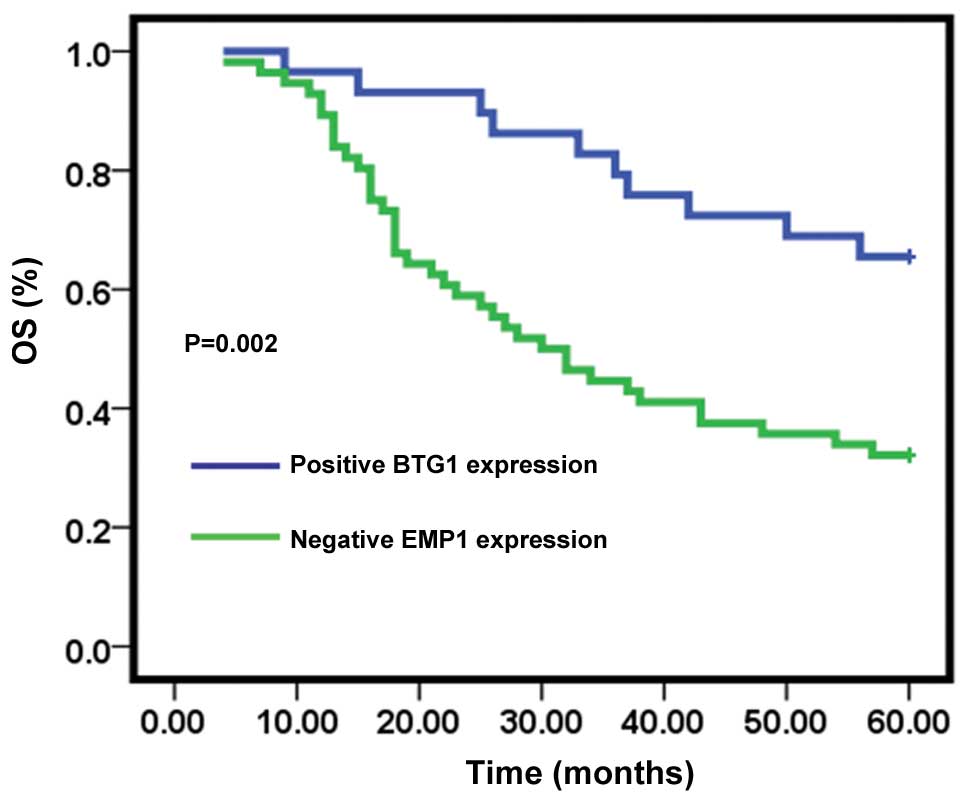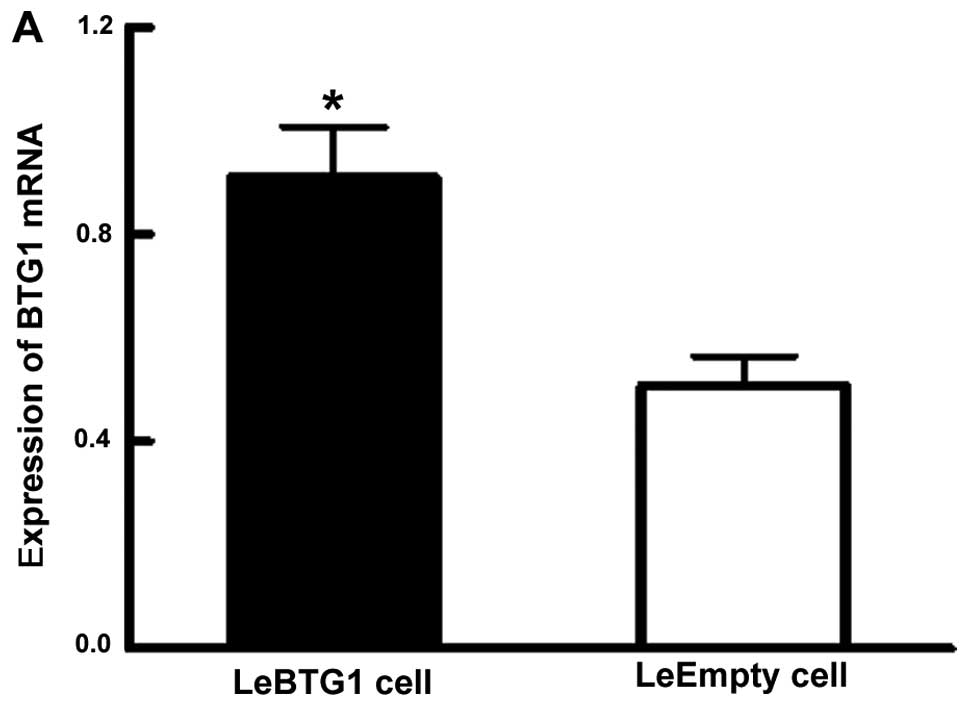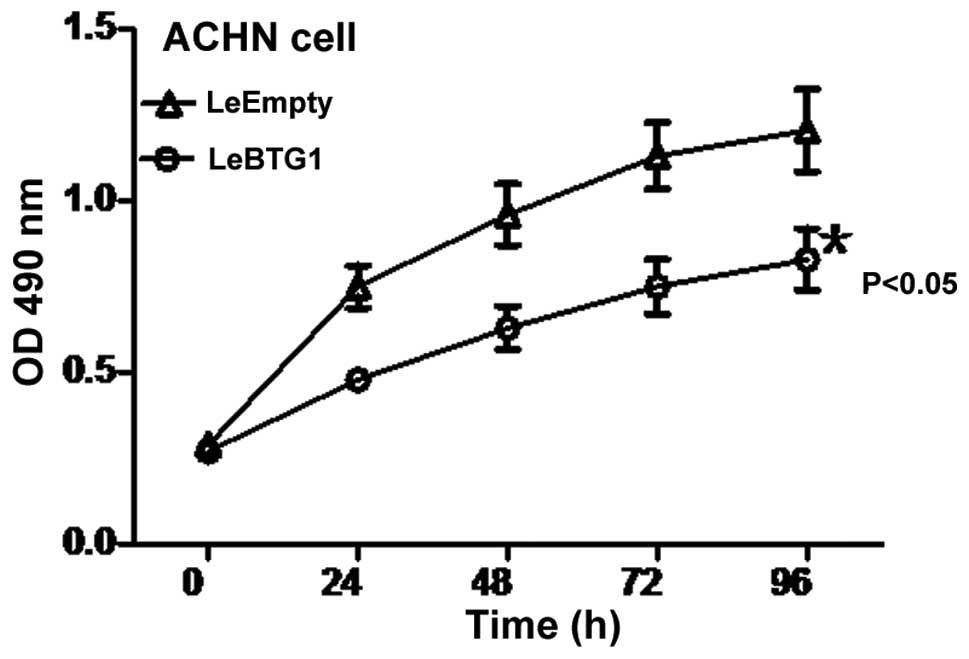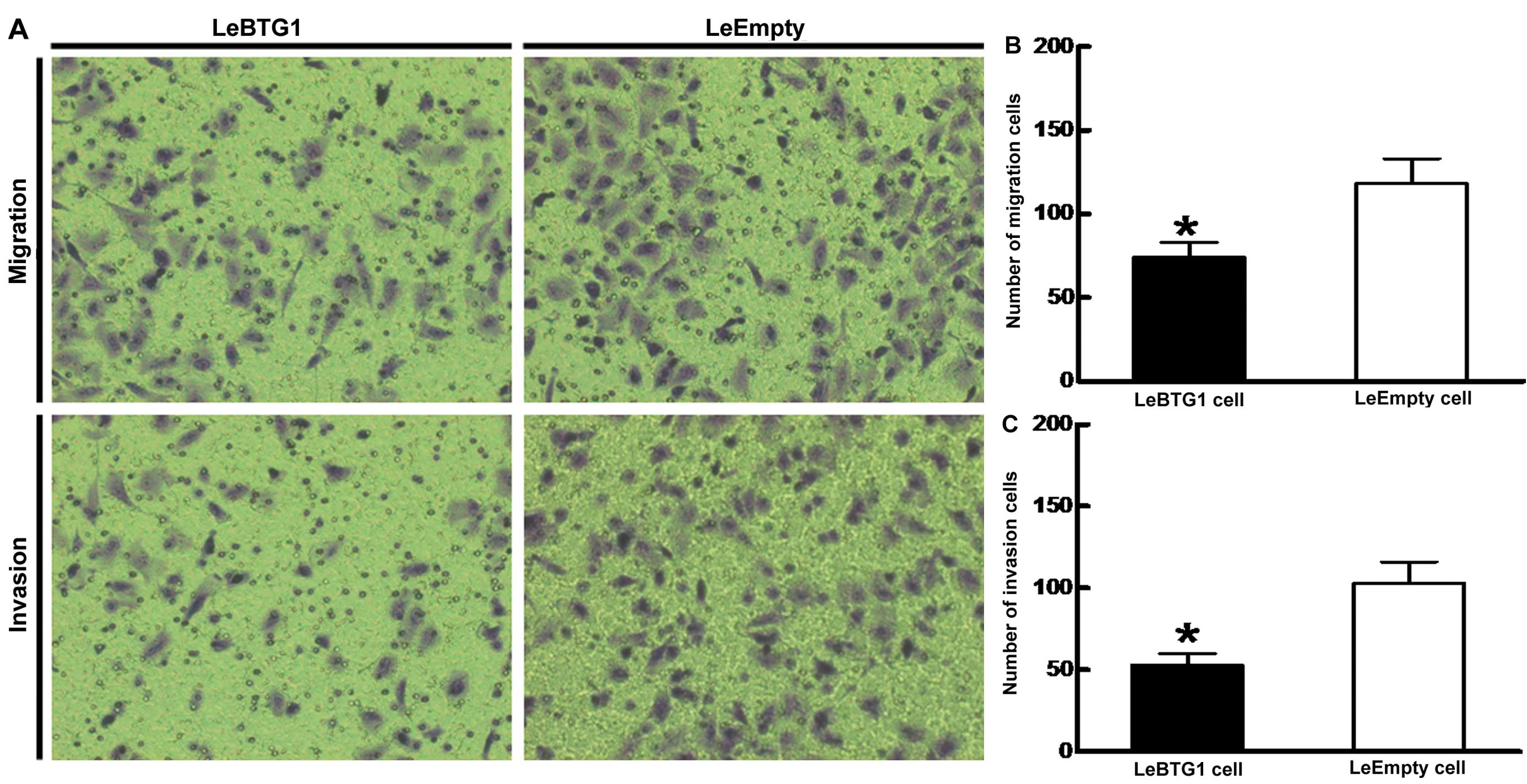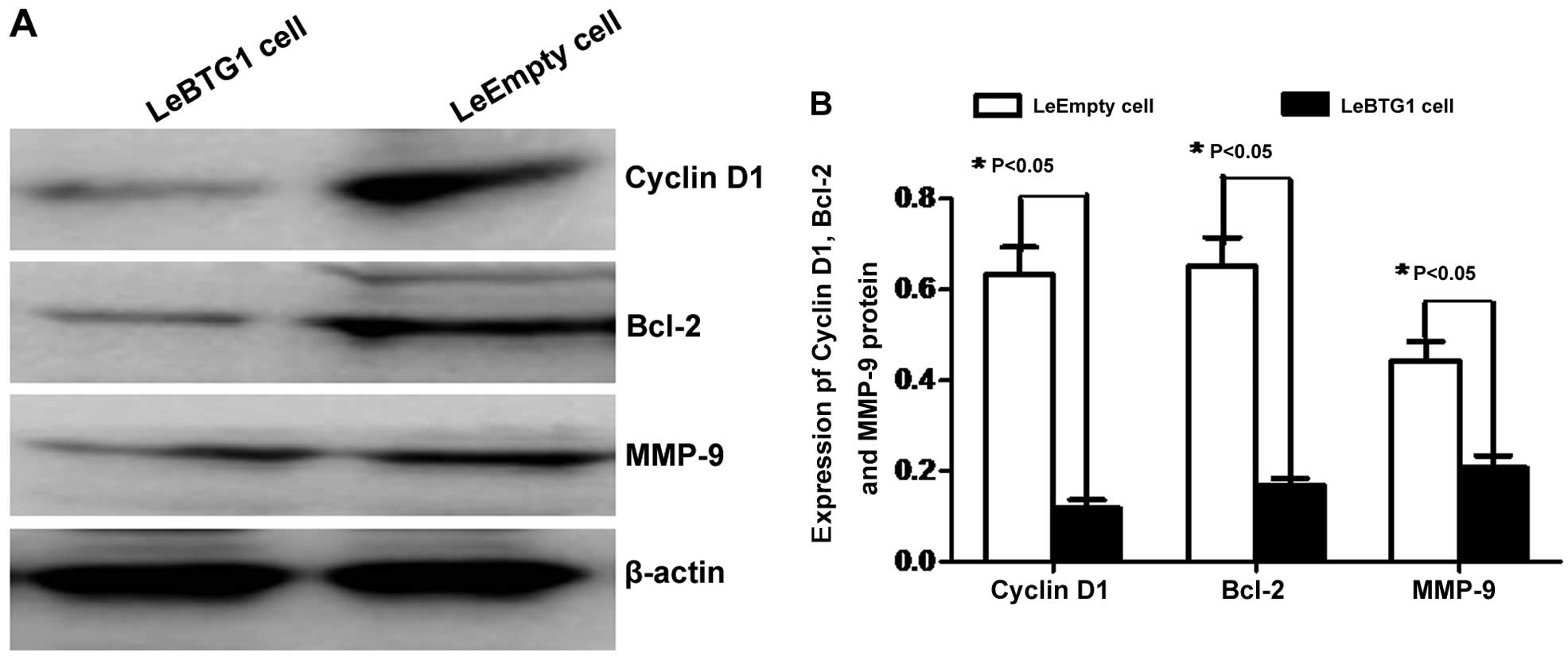B cell translocation gene 1 reduces the biological outcome of kidney cancer through induction of cell proliferation, cell cycle arrest, cell apoptosis and cell metastasis
- Authors:
- Published online on: December 31, 2014 https://doi.org/10.3892/ijmm.2014.2058
- Pages: 777-783
Abstract
Introduction
Cellular proliferation, differentiation, senescence and apoptosis are cell cycle-dependent processes (1). Regulation of the cell cycle is closely linked to tumor development and progression, as it is impaired in almost all tumors (2,3). In addition, numerous proto-oncogenes and tumor suppressor genes function as major factors or are directly involved in the regulation of cell cycle (4). Carcinogenic factors can induce mutation, deletion, translocation or amplification of these genes, resulting in de-regulation of the cell cycle, abnormal cell proliferation and tumor development. A novel strategy for cancer therapy involves regulating cell cycle, proliferation and apoptosis of tumor cells and select inhibition of tumor tissue activity (5).
B cell translocation gene 1 (BTG1) is a member of the TOB/BTG family of proteins known to inhibit cell proliferation and negatively regulate the cell cycle that was first identified in B lymphoblastic leukemia (6–9). The TOB/BTG family members regulate these processes by acting on cell cycle genes in response to various internal and external stimuli. For example, high PC3 expression in NIH/3T3 cells arrests the cell cycle in the G1 phase and inhibits cell growth (10). Enhanced BTG1 expression, which peaks in the G0/G1 phase, promotes the differentiation of neural stem and germ cells and plays an important role in angiogenesis. BTG1 also facilitates the formation of the CCR4/NOT transcriptional complex, which regulates the deadenylation and turnover of cytoplasmic mRNAs. BTG1 is structurally characterized by the presence of a specific BTG domain in the N terminus along with a large anti proliferative homologous region (11). Although BTG1 exhibits certain characteristics of tumor suppressor genes (12,13), it is not known if BTG1 is a kidney cancer suppressor gene. Therefore, the present study aimed to determine what roles BTG1 plays in the growth, proliferation, invasion, metastasis and apoptosis of kidney cancer cells.
Materials and methods
Reagents
The rabbit anti-human BTG1 monoclonal (14879-1-AP and 14102-1-AP) antibodies were purchased from Proteintech Group (Chicago, IL, USA). Rabbit anti-human cyclin D1 polyclonal (ab7958), mouse anti-human Bcl-2 monoclonal (ab117115), and rabbit anti-human MMP-9 polyclonal (ab7299) antibodies were purchased from Abcam (Cambridge, UK). Goat anti-rabbit fluorescent secondary antibody (IRDye800) was obtained from LI-COR Biosciences, Inc. (Lincoln, NE, USA). The β-actin primary antibody (A1978), polyoxymethylene and crystal violet were purchased from Sigma (St. Louis, MO, USA). The pLenti6/V5-DEST vector, Lentiviral Packaging Mix, Opti-MEM, Lipofectamine 2000 and TRIzol were obtained from Invitrogen (Thermo Fisher Scientific, Waltham, MA, USA). An immunohistochemistry and Annexin V-fluorescein isothiocyanate (FITC)/propidium iodide (PI) apoptosis detection kit were purchased from 4A Biotech Co., Ltd. (Beijing, China). Fetal bovine serum (FBS), cell-culture media and supplementary materials were obtained from Gibco (Thermo Fisher Scientific). Reverse transcriptase reagents and SYBR Premix ExTaq (Perfect real-time) were purchased from Takara (Shiga, Japan). Invasion chambers and Matrigel for invasion and migration assays were purchased from BD Biosciences (Franklin Lakes, NJ, USA).
Cell culture and gene transfection
The human kidney cancer cell line ACHN was maintained in RPMI-1640 medium supplemented with 10% FBS, which was changed every 2–3 days. Upon reaching confluence, cells were subcultured with 0.25% trypsin and 1% ethylenediaminetetraacetic acid. BTG1 cDNA sequences were cloned into the BamHI and AscI sites of the pLenti6/V5-DEST vector, and cells were transfected with the pLenti6-BTG1 or pLenti6/V5-DEST vector using Lipofectamine 2000. Transfected cells were maintained in blastidicin (5 μg/ml)-containing RPMI-1640 medium for selection of stable vector-containing sublines.
Immunohistochemistry
Immunohistochemistry was performed as previously described (14). Briefly, 4-μm sections were prepared from paraffin-embedded biopsy samples and dehydrated. Sections were incubated in 3% hydrogen peroxide for 10 min to block endogenous peroxidase, followed by 20 min in 0.05% trypsin. Sections were incubated for 20 min at room temperature in a blocking solution containing 10% goat serum followed by the BTG1 antibody (1:100) at 4°C overnight. For a negative control, the primary antibody was replaced with phosphate-buffered saline (PBS). Sections were subsequently incubated for 20 min each in secondary and tertiary antibodies at room temperature, visualized by 3,3′-diaminobenzidine staining and countered with a hematoxylin stain. Two pathologists blind to the patient condition examined and quantified the sections. Five randomly-selected fields from three slides for each specimen were examined under a microscope and counted. BTG1 expression was determined based on the percentage of positive cells (0 points, ≤5%; 1 point, 5–25%; 2 points, 25–50%; and 3 points, >50% positive cells) and the staining intensity [0 points, no staining; 1 point, weak staining (light yellow); 2 points, moderate staining (yellowish-brown); and 3 points, strong staining (brown)]. The final score of BTG1 expression was the product of the BTG1 expression rate (percentage score) and intensity: - for 0 points, + for 1–3 points, ++ for 4–6 points and +++ for 7–9 points.
Reverse transcription-quantitative polymerase chain reaction (RT-qPCR)
Total RNA was extracted from ACHN cells using the TRIzol reagent according to the manufacturer's instructions. Total RNA (500 ng) was reverse transcribed using reverse transcriptase, and RT-qPCR was performed on an ABI Prism 7300 Real-Time PCR system (Applied Biosystems Inc., Life Technologies/Thermo Fisher Scientific) according to the standard manufacturer’s instructions for SYBR Premix ExTaq. Gene specific primers used include: BTG1, sense, 5′-GGAATTCATGCATCCCTTCTACACCCGG; and anti-sense, 5′-CGACGCGTTTAACCTGATACAGTCATCAT; and β-actin for normalization, sense, 5′-ATCGTCCACCGCAAATGCTTCTA and antisense, 5′-AGCCATGCCAATCTCATCTTGTT. Thermal cycling conditions were 95°C for 1 min, followed by 40 cycles of 95°C for 15 sec and 60°C for 1 min. The expression level relative to β-actin was calculated using the 2−ΔΔCt method in SDS 1.3 software (Applied Biosystems, Inc.).
Western blotting
Western blotting was performed as previously described (15). Briefly, 50 μg of protein [determined using a bicinchoninic acid Protein Assay kit (Tiangen Biotech Co., Ltd., Beijing, China)] per samples were subjected to sodium dodecyl sulfate-polyacrylamide gel electrophoresis and transferred to a nitrocellulose membrane. Membranes were incubated for 2 h in 5% skimmed dry milk followed by an overnight incubation at 4°C in primary antibody (BTG1, 1:1,000; β-actin, 1:5,000). Subsequent to washing, the membranes were incubated with goat anti-rabbit fluorescent secondary antibody (IRDye800, 1:20,000 dilution) in the dark for 1 h at room temperature. The blots were scanned and analyzed using the Odyssey Infrared Imaging System (LI-COR Biosciences, Inc.). Western blot data were quantified by normalizing the BTG1 signal intensity of each sample to that of β-actin.
MTT assay
Cell viability was determined using the tetrazolium salt MTT (3-(4,5-dimethylthiazol-2-yl)-2,5-diphenyltetrazolium bromide) assay, as previously described (16). Briefly, ACHN cells were plated into 96-well culture plates at an optimal density of 5×103 cells/ml with 200 μl/well. After 24–96 h, 20 μl of 5 mg/ml MTT was added to each well and incubated at 37°C for 4 h. Subsequently, the medium was gently aspirated and 150 μl of dimethyl sulfoxide was added to each well to solubilize the formazan crystals. The optical density of each sample was immediately measured at 570 nm using a microplate reader (Bio-Rad Laboratories, Hercules, CA, USA).
Flow cytometry
An Annexin V-FITC-flow cytometry assay was used as previously described (17) to detect the apoptosis rate. Cells were plated into 60-mm dishes for 48 h and grown to 70–75% confluency Cells were subsequently collected, washed with ice-cold PBS and resuspended at a density of 1×106 cells/ml in a binding buffer and incubated for 15 min in the dark at 25°C with 5 μl Annexin V-FITC and 10 μl PI (20 μg/ml). A total of 10,000 cells were analyzed with a FACScan flow cytometer with CellQuest software (BD Biosciences) for the apoptosis rate determination. For cell cycle distribution, 1×106 cells were fixed in 70% ethanol and resuspended in 1 ml of a solution containing 3.8 mM sodium citrate, 50 μg/ml PI, and 0.5 μg RNase A, and analyzed with the flow cytometer using the ModFit software program (Verity Software House, Topsham, ME, USA).
Invasion and migration assays
Invasion and migration assays were performed as previously described (18). Briefly, 8×105 cells were plated into Invasion Chambers with Costar Transwell 8-μm inserts coated with 50 μg reduced serum Matrigel according to the manufacturer's instructions. Medium supplemented with 10% FBS was used in the lower chamber. Migration assays were performed in the same manner excluding the Matrigel. After 12 h, non-invading cells and media were removed with a cotton swab. Cells on the lower surface of the membrane were fixed with polyoxymethylene and stained with 0.1% crystal violet for 30 min. Stained cells were counted under a microscope in four randomly-selected fields and the average was used to indicate cell migration and invasion.
Statistical analyses
All the statistical analyses were performed using the SPSS 16.0 software (IBM, Armonk, NY, USA), according to published guidelines (19). Survival distributions were estimated with the Kaplan-Meier method and compared with the log-rank test. Student’s t-test, χ2 and Fisher’s exact tests were used to analyze the differences between groups. Data are presented as the mean ± standard error, and P<0.05 was considered to indicate a statistically significant difference.
Results
BTG1 protein expression in normal tissue and kidney cancer
Immunohistochemistry for BTG1 revealed light yellow to brown staining in 77.5% (31/40) of normal kidney tissues, and negative or weak staining in 34.1% (29/85) kidney cancer tissues (P <0.05) (Table I, Fig. 1). Furthermore, BTG1 protein expression was significantly lower in cancer lesion samples compared to adjacent normal tissue, as determined by western blot analysis (0.481±0.051 vs. 0.857±0.081; P<0.05) (Fig. 2). BTG1 expression levels correlated with T stage, lymph node metastasis, clinical stage and pathological differentiation (P<0.05), regardless of age, gender, tumor size and pathological types (P>0.05) (Table II).
BTG1 expression and prognosis
Follow-up examinations were performed on cancer patients for up to 60 months, with 37 patients remaining at the conclusion of the study. Overall survival (OS) rates were determined between patients positive for BTG1 expression and those negative for expression. Thirteen of the 56 individuals showing no BTG1 expression remained at the conclusion of the study, with an OS rate of 32.1%. Patients positive for BTG1 expression had a significantly higher OS rate of 65.5% (19/29) (P<0.05) (Fig. 3).
Stable transfection of BTG1 in kidney cancer cells
BTG1 overexpressing ACHN cells (known as LeBTG1) were obtained by a stable transfection of BTG1 cDNA, and compared to ACHN cells overexpressing an empty vector (named LeEmpty) as a control. Analysis of RT-qPCR data showed that LeBTG1 cells had a significantly higher expression of BTG1 mRNA compared to LeEmpty cells (0.911±0.095 vs. 0.508±0.055; P<0.05) (Fig. 4A). Furthermore, western blot analysis showed that LeBTG1 cells had a significantly higher expression of BTG1 protein compared to LeEmpty cells (0.871±0.089 vs. 0.429±0.045; P<0.05) (Fig. 4B).
Cellular effects of BTG1 overexpression
LeBTG1 cells had a significantly lower viability at 24, 48, 72 and 96 h compared to LeEmpty cells as assessed by an MTT assay (P<0.05) (Fig. 5). Cell cycle analysis using flow cytometry showed that the proportion of LeBTG1 cells in the G0/G1 and S phases of the cell cycle were significantly different compared to the control LeEmpty cells (66.8±5.3 and 22.2±1.5 vs. 44.4±3.1 and 34.5±2.3%, respectively; P<0.05) (Fig. 6). In addition, there was a large increase in the early apoptosis rate in LeBTG1 cells compared to control LeEmpty cells (16.6±2.5 vs. 6.1±0.7%; P<0.05) (Fig. 7). Furthermore, LeBTG1 cells had a reduced capability for invasion and migration through Transwell inserts (74.0±9.0 and 53.0±7.0, respectively) compared to control LeEmpty cells (118.0±15.0 and 103.0±13.0, respectively; P<0.05) (Fig. 8).
To further identify the mechanisms by which BTG1 overexpression regulated these cellular changes in cancer cells, expression levels of proteins critical for the regulation of cell cycle, apoptosis and migration were examined. Western blot analysis revealed that LeBTG1 cells had significantly reduced levels of cyclin D1, Bcl-2 and MMP-9 (0.118±0.018, 0.169±0.015 and 0.207±0.027, respectively) compared to control LeEmpty cells (0.632±0.061, 0.651±0.063 and 0.443±0.042, respectively; P<0.05) (Fig. 9).
Discussion
Tumor development and progression are associated with uncontrolled proliferation and reduced apoptosis of tumor cells. BTG1 has been show to act as a tumor suppressor gene in breast cancer, by inhibiting proliferation, regulating cell cycle and inducing apoptosis (20). The present study examined BTG1 protein expression in kidney cancer tissue and showed that levels were significantly lower and correlated with tumor invasion, lymph node metastasis, clinical stage and cancer differentiation. A recent study suggests that tumor stage is the preferred prognostic indicator (21), although prognoses can vary considerably among patients in the same stage. Therefore, it is of particular importance to identify reliable molecular markers for use in clinical practice. The results of the present study indicate that BTG1 deletion is a major contributor to the development and progression of kidney cancer. As expression-positive patients had a significantly higher 5-year overall survival rate, BTG1 may be a useful prognostic indicator for patients with kidney cancer. The combination of the tumor-node-metastasis classification system and BTG1 expression scores may provide certain valuable information for clinicians in choosing treatment options, and for predicting disease severity and prognosis.
The development of kidney cancer is driven by the abnormal proliferation of cells that normally undergo apoptosis (22). A recent study has indicated that overexpression of BTG1 can affect the cell cycle and suppress tumor growth (20). The present study utilized in vitro tests to confirm that kidney cancer cells with a high BTG1 expression had significantly weakened viability and proliferation potential. In addition, BTG1 overexpression resulted in decreased protein levels of cyclin D1, which is considered to be a proto-oncogene product that is highly expressed or mutated in a variety of human tumors (23). The increased BTG1 expression in kidney cancer ACHN cells resulted in a higher proportion of cells in the G0/G1 phase, indicating the occurrence of G0/G1 arrest and inhibition of growth. Taken together, the data implicate BTG1 in cell cycle regulation and cyclin D1 expression.
In the present study, increased BTG1 expression in kidney cancer cells reduced the amount of the anti-apoptotic protein Bcl-2 and induced apoptosis. Apoptosis is a programmed death process that involves a series of changes in relevant genes, including Bcl-2 and caspase family genes, oncogenes such as C-myc, and the tumor suppressor gene p53 (24), and is regulated by numerous internal and external factors (25). These results are in agreement with previous works linking BTG1 expression with apoptosis. Corjay et al (26) demonstrated a high level of BTG1 expression in apoptotic cells within macrophage-rich tissues in patients with hereditary hyperlipidemia, and Lee et al (27) showed that BTG1 could induce apoptosis in glioma cells. Additionally, a study by Nahta et al (28) found that apoptosis in kidney cancer MCF7 cells induced by Bcl-2 knockdown was regulated by BTG1 expression. Therefore, the evidence indicates that BTG1 can inhibit the growth of kidney cancer cells by reducing Bcl-2 expression.
Tumor invasion and metastasis are major causes for treatment failures, thus, the main research aims are to identify the molecular mechanisms underlying metastasis and target key pathways that inhibit this process. Tumor invasion and metastasis share common molecular mechanisms and involve a number of changes in tumor cells and the microenvironment, including altered tumor cell adhesion properties, enhanced proliferation, survival, chemotaxis and migration of tumor cells, lymphangiogenesis, evasion of immune attack and hydrolysis of surrounding matrix proteins (29). A key step in tumor invasion and clonal growth is the remodeling of the extracellular matrix and basement membranes through proteolytic degradation by MMPs, which are highly expressed by tumor cells with malignant, invasive and metastatic phenotypes. Additionally, the degree of malignancy and patient prognosis are associated with excessive expression of MMP-2 and MMP-9 (30,31). Tumor cells can also regulate the expression of MMPs produced by stromal cells by secreting chemokines, cytokines and extracellular MMP inducer, a cell surface glycoprotein. The present study showed that BTG1-overexpressing kidney cancer cells had decreased MMP-9 protein levels and reduced invasion and migration in vitro, indicating that BTG1 modulated tumor cell metastasis by downregulating MMP-9 expression.
In conclusion, the present study provides clinical and in vitro evidence implicating BTG1 in the development and progression of kidney cancer. The results of this study show that BTG1 protein levels were significantly reduced in kidney cancer biopsy specimens and were associated with disease progression and prognosis. Furthermore, the effects on the regulation of cancer cell proliferation, apoptosis, invasion and metastasis indicate that BTG1 expression may serve as a prognostic marker for kidney cancer patients.
References
|
Agathocleous M and Harris WA: Metabolism in physiological cell proliferation and differentiation. Trends Cell Biol. 23:484–492. 2013. View Article : Google Scholar : PubMed/NCBI | |
|
Hofmockel G: Molecular genetic principles of tumor development and progression. Urologe A. 39:212–213. 2000.(In German). PubMed/NCBI | |
|
Shibata D and Aaltonen LA: Genetic predisposition and somatic diversification in tumor development and progression. Adv Cancer Res. 80:83–114. 2001. View Article : Google Scholar | |
|
Lee EY and Muller WJ: Oncogenes and tumor suppressor genes. Cold Spring Harb Perspect Biol. 2:a0032362010. View Article : Google Scholar : PubMed/NCBI | |
|
Okuyama T, Maehara Y, Kabashima A, Takahashi I, Kakeji Y and Sugimachi K: Combined evaluation of expressions of p53 and p21 proteins as prognostic factors for patients with gastric carcinoma. Oncology. 63:353–361. 2002. View Article : Google Scholar : PubMed/NCBI | |
|
Vadgama JV, Scuric Z, Chakrabarti R, Marzo E, Shen D and Wu Y: Insulin-like growth factor I differentially regulates the expression of HIRF1/hCAF1 and BTG1 genes in human MCF-7 breast cancer cells. Int J Mol Med. 18:129–139. 2006.PubMed/NCBI | |
|
Cortes U, Moyret-Lalle C, Falette N, Duriez C, Ghissassi FE, Barnas C, Morel AP, Hainaut P, Magaud JP and Puisieux A: BTG gene expression in the p53-dependent and -independent cellular response to DNA damage. Mol Carcinog. 27:57–64. 2000. View Article : Google Scholar : PubMed/NCBI | |
|
Winkler GS: The mammalian anti-proliferative BTG/Tob protein family. J Cell Physiol. 222:66–72. 2010. View Article : Google Scholar | |
|
Rouault JP, Rimokh R, Tessa C, Paranhos G, Ffrench M, Duret L, Garoccio M, Germain D, Samarut J and Magaud JP: BTG1, a member of a new family of antiproliferative genes. EMBO J. 11:1663–1670. 1992.PubMed/NCBI | |
|
Rouault JP, Falette N, Guéhenneux F, Guillot C, Rimokh R, Wang Q, Berthet C, Moyret-Lalle C, Savatier P, Pain B, Shaw P, Berger R, Samarut J, Magaud JP, Ozturk M, Samarut C and Puisieux A: Identification of BTG2, an antiproliferative p53-dependent component of the DNA damage cellular response pathway. Nat Genet. 14:482–486. 1996. View Article : Google Scholar : PubMed/NCBI | |
|
Matsuda S, Rouault J, Magaud J and Berthet C: In search of a function for the TIS21/PC3/BTG1/TOB family. FEBS Lett. 497:67–72. 2001. View Article : Google Scholar : PubMed/NCBI | |
|
Bozec A, Peyrade F and Milano G: Molecular targeted therapies in the management of head and neck squamous cell carcinoma: recent developments and perspectives. Anticancer Agents Med Chem. 13:389–402. 2013. | |
|
Suzuki K, Nakamura K, Kato K, Hamada H and Tsukamoto T: Exploration of target molecules for prostate cancer gene therapy. Prostate. 67:1163–1173. 2007. View Article : Google Scholar : PubMed/NCBI | |
|
Turashvili G, Bouchal J, Ehrmann J, Fridman E, Skarda J and Kolar Z: Novel immunohistochemical markers for the differentiation of lobular and ductal invasive breast carcinomas. Biomed Pap Med Fac Univ Palacky Olomouc Czech Repub. 151:59–64. 2007. View Article : Google Scholar : PubMed/NCBI | |
|
Ranganathan V and De PK: Western blot of proteins from Coomassie-stained poly-acrylamide gels. Anal Biochem. 234:102–104. 1996. View Article : Google Scholar : PubMed/NCBI | |
|
van Meerloo J, Kaspers GJ and Cloos J: Cell sensitivity assays: the MTT assay. Methods Mol Biol. 731:237–245. 2011. View Article : Google Scholar : PubMed/NCBI | |
|
Rasola A and Geuna M: A flow cytometry assay simultaneously detects independent apoptotic parameters. Cytometry. 45:151–157. 2001. View Article : Google Scholar : PubMed/NCBI | |
|
Kramer N, Walzl A, Unger C, Rosner M, Krupitza G, Hengstschläger M and Dolznig H: In vitro cell migration and invasion assays. Mutat Res. 752:10–24. 2013. View Article : Google Scholar | |
|
Richards RJ: Responsibility for statistical analyses. Endocr Pract. 9:3292003.PubMed/NCBI | |
|
Zhu R, Zou ST, Wan JM, Li W, Li XL and Zhu W: BTG1 inhibits breast cancer cell growth through induction of cell cycle arrest and apoptosis. Oncol Rep. 30:2137–2144. 2013.PubMed/NCBI | |
|
Manjili MH, Najarian K and Wang XY: Signatures of tumor-immune interactions as biomarkers for breast cancer prognosis. Future Oncol. 8:703–711. 2012. View Article : Google Scholar : PubMed/NCBI | |
|
Martinez-Outschoorn UE, Pavlides S, Sotgia F and Lisanti MP: Mitochondrial biogenesis drives tumor cell proliferation. Am J Pathol. 178:1949–1952. 2011. View Article : Google Scholar : PubMed/NCBI | |
|
Koff A, Cross F, Fisher A, Schumacher J, Leguellec K, Philippe M and Roberts JM: Human cyclin E, a new cyclin that interacts with two members of the CDC2 gene family. Cell. 66:1217–1228. 1991. View Article : Google Scholar : PubMed/NCBI | |
|
Tirone F: The gene PC3(TIS21/BTG2), prototype member of the PC3/BTG/TOB family: regulator in control of cell growth, differentiation, and DNA repair? J Cell Physiol. 187:155–165. 2001. View Article : Google Scholar : PubMed/NCBI | |
|
Nicholson DW and Thornberry NA: Apoptosis. Life and death decisions. Science. 299:214–215. 2003. View Article : Google Scholar : PubMed/NCBI | |
|
Corjay MH, Kearney MA, Munzer DA, Diamond SM and Stoltenborg JK: Antiproliferative gene BTG1 is highly expressed in apoptotic cells in macrophage-rich areas of advanced lesions in Watanabe heritable hyperlipidemic rabbit and human. Lab Invest. 78:847–858. 1998.PubMed/NCBI | |
|
Lee H, Cha S, Lee MS, Cho GJ, Choi WS and Suk K: Role of antiproliferative B cell translocation gene-1 as an apoptotic sensitizer in activation-induced cell death of brain microglia. J Immunol. 171:5802–5811. 2003. View Article : Google Scholar : PubMed/NCBI | |
|
Nahta R, Yuan LX, Fiterman DJ, Zhang L, Symmans WF, Ueno NT and Esteva FJ: B cell translocation gene 1 contributes to antisense Bcl-2-mediated apoptosis in breast cancer cells. Mol Cancer Ther. 5:1593–1601. 2006. View Article : Google Scholar : PubMed/NCBI | |
|
Wiseman BS and Werb Z: Stromal effects on mammary gland development and breast cancer. Science. 296:1046–1049. 2002. View Article : Google Scholar : PubMed/NCBI | |
|
Alok C and Bharat B: Nuclear factor-kappa Band cancer: its role in prevention and therapy. Biochem Phamacol. 64:883–888. 2002. View Article : Google Scholar | |
|
Virós D, Camacho M, Zarraonandia I, García J, Quer M, Vila L and León X: Prognostic role of MMP-9 expression in head and neck carcinoma patients treated with radiotherapy or chemoradiotherapy. Oral Oncol. 49:322–325. 2013. View Article : Google Scholar |



